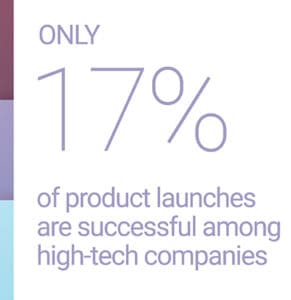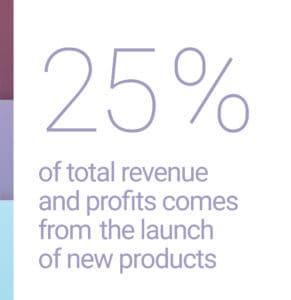Microsoft’s release of Windows 95 was a tremendous success: seven million copies sold in the first five weeks and it soon became the de facto operating system on the market.
The company invested $300 million in a marketing campaign to create the hype surrounding the launch. And who can forget the hoopla?
Acquiring the rights to the Rolling Stones’ song, “Start Me Up,” as the anthem for the iconic “Start” button cost $3 million alone, but it made Microsoft a household name and propelled the brand to the mass market.
Few companies have that kind of marketing budget allocated for their product’s entire lifecycle, let alone an initial launch. The good news is that you don’t have to spend hundreds of millions to attain product launch success. But you do need to pay attention to the planning and preparation because incorporating those elements as an afterthought is a guaranteed path to failure for a product launch.

Many oversimplify why their product launch failed, often citing either:
- Not starting planning and preparation early enough, or
- Releasing a product before it’s ready for release.
Hurdling past these two factors is product launch table stakes. However, often ignored, market and competitive intelligence (M&CI) coupled with market research also play a vital role in ensuring a successful product launch.
In the spirit of “launch” as a metaphor, this article explores a three-stage-to-orbit system to describe the ideal product launch process. These stages include determining objectives and corresponding launch type, bypassing common launch mistakes, and continued maintenance for successful orbit.
Stage 1: Determine Objectives and Launch Type
How many times has an organization used inaccurate terms for “announcement,” “launch,” and “release,” only to create customer confusion?
It’s important to define these terms within the organization, along with establishing time intervals between each phase; in days, weeks, and months.
Determine the objectives you want to accomplish and associate it with a launch type. Here are the attributes for three commonly used launch types, which are associated with a respective tier, from most extensive to least extensive:
- Major launch (portfolio-level change): a “full-scale launch,” the goal is to maximize awareness and generate significant leads and sales. This tier targets many vertical segments and is intended to give the product and platform the best chance at success. Many times, this launch puts the company on the map (think Gartner Magic Quadrant). These launches require changes to existing processes and systems because they are the result of a new product, extensive added features or architectural changes. It’s when the term “forklift upgrade” is used due to those significant changes involved.
- Minor launch (product-level change): the product may not be fully ready for prime time and could be deployed to a limited, micro-targeted set of customers in a particular vertical segment. In this tier, it makes sense to get the product out, receive quick market feedback and have the product team iterate quickly. This tier provides a cautious approach as the organization may not have the funds or resources to properly launch the product. There may also be a risk of shipping date slippage or uncertainty of product readiness and acceptance.
- Enhancement launch (update to an existing product): an insignificant, minor revision, the associated release often includes just release notes and an email announcement to existing customers. There’s seldom any press coverage involved.
After determining your objectives and launch type, schedule a timeline complete with milestones, assign roles and responsibilities, and allocate a budget.
Your budget should range from 5% to 20% of anticipated revenue. It takes an average range of three to nine months for a successful launch, depending on the launch type, maturity of the market, and type of offering.
Stage 2: Bypass Common Launch Mistakes to Achieve Liftoff
Mistake 1: Not Using Metrics in Launch and Post-Launch Assessment

McKinsey highlights that more than 25% of total revenue and profits comes from the launch of new products. Sales Benchmark Index (SBI) has developed a calculator to help with this return on product launch assessment.
Competitive intelligence metrics can only be assessed post-launch, and many of these effects are not seen immediately. However, they’re vital in justifying the value that competitive intelligence brings to an organization.
Those metrics are:
- Supported deals, and improved win/loss ratio
- Defended sales revenue (existing), and influenced sales pipeline (future)
- Increased average deal size, and shortened sales cycle
- Derived features listed on the product roadmap
- Produced field enablement tools and sales training material
Mistake 2: Not Knowing the Phase in the Tech Market Model (TMM) You are Competing In
How do your customers view your and your competitors’ tech product or service offering? Are they ready to adopt the innovation? Are customers delaying adoption? Or, worse, are they going to permanently reject the offer?
Chasm Institute’s Tech Market Model (TMM) can be used to assess your company and product’s market stage during a launch. This model maps, analyzes and illustrates the likely adoption or acceptance of a new product or innovation.
For example, venture capitalists love to ask about the total addressable market (TAM) as one of their key investment criteria. But it’s useless during the early market. Ideas are still being generated during this phase. At the time of their Series A funding, many successful venture investments would have had relatively insignificant or even undefined TAMs—Amazon, eBay, Google, LinkedIn and Uber are some examples.
Another mistake made in an early adopter market is biting off more than you can swallow by going after too many markets. Before a launch, market segments need to be clearly defined. Ideal customer profiles and effective buyer personas should be developed through interviews and industry research.
One caution: Don’t confuse the product lifecycle with the Tech Market Model. The product life cycle is important, but it’s company-based and internally focused. The Tech Market Model takes an outside-in approach, looking through the customers’ lens.
Mistake 3: Your Launch Creates Confusion with New or Existing Customers
We started out by talking about the wildly successful Windows 95. But there was another product that Microsoft released that still causes people to cringe: Windows 8.
A key reason for this was the use of a new, tile-based UI, full-screen “Start” menu and a confusing interface for keyboard and mouse users that was Microsoft’s attempt to mimic the iPad—but the company forgot the institutional memory of its own PC user base.
Microsoft should have conducted a needs assessment, based on research and testing, to ensure that they could compel buyers to both make the shift to the new operating system and, once purchased, quickly grasp how to use the operating system.
Windows 8 was a muddled offering with an identity crisis. Microsoft treated the product like a disruptive innovation for early adopters, while it should have treated and launched as a more continuous innovation for their mainstream installed base.
Chasm Institute highlights three requirements for a product to be a truly disruptive innovation that appeals to early adopters:
- A change in skill
- A change in behavior or mindset
- A change in workflow or process
In looking at the evolution of Microsoft operating systems, Windows 3.0 was the product poster child for disruptive innovation. Previously, users were accustomed to using DOS and its command-line interface for computers. Windows 3.0 revolutionized how PC users expected to view and interact with their information.
When thinking about your product or service’s launch, make sure to employ various methods to validate the hypotheses around your offering. Validation methods include prototype design, surveys, and A/B testing. These methods also help when refuting executives’ and product professionals’ “best thing since sliced bread” soapbox.
Mistake 4: Mimicking the Competitors’ Pricing
Pricing is an instrumental part of your product launch, but many companies make the mistake of setting their price based on competitors’ pricing.
Also referred to as “the going rate,” this creates a customer perception that your product or service is a “me-too” offering that requires them to choose between two companies’ indistinguishable products. Mimicking competitor pricing is also a great way to initiate a price war that leads to pricing erosions and subsequent lower margins.
By not factoring in your customer segments’ willingness to pay, overall company strategy, and variable cost structure, mimicking the competitors’ pricing just leads to additional competitor vulnerability. When setting prices, it’s the one time when it’s OK to say, “We’re not focusing on the competition.”
The better alternative to use is value-based pricing. Value-based pricing requires a deeper understanding of customers’ needs and wants, and it reinforces sustainable differentiation.
Setting value-based pricing enforces the company to ignore fixed costs, since they’re irrelevant in this pricing model. It’s easier for software companies to grasp this concept because there are no economies of scale involved; computer hardware and manufacturing-intensive companies, in industries like consumer-packaged goods, have a harder time accepting this.
Mistake 5: Not Anticipating the Reaction to Your Launch
For every action, there is an equal and opposite reaction. Enter war games, which predict competitive responses that allow you to adjust your launch to counter reactions.
While war games can be used in several areas of product management and product marketing, wargaming pioneer Ben Gilad estimates that 90% of the application of his war games are focused on product launch, whether it’s one’s own company or a competitor’s.
For example, a consumer product company known for a low-cost, low-priced product planned to upgrade that product and then launch it at a higher price point. A war game predicted a fierce response from the market leader who had a close relationship with a dominant retail channel.
The retailer would be at-risk of losing its loyal customer base that depended on the low-price product. Ultimately, the plan was scratched. Later, the company launched a different, higher-end product with its own brand. The company also targeted a different retail route for its market entry point.
Product launch failure typically is a result of a disconnect between plan designers (e.g., senior executives, VPs, strategic planners) and those who need to implement the launch plan (e.g., marketers, salespeople, sometimes R&D and manufacturing). A war game that combines these two groups brings the market reality back to the plan at a fraction of the cost of failure.
Stage 3: Maintaining Orbit
At this stage, your product has launched smoothly, and your product or service has been well received by the market. Your deliverables can be broken into two phases of the product life cycle: idea-to-launch and launch-to-withdrawal. While there’s no clear demarcation between the two phases, idea-to-launch is about achieving a successful liftoff while launch-to-withdrawal is about maintaining a sustained orbit. Your launch activities start with idea-to-launch and continue through launch-to-withdrawal. Here’s a comprehensive, sequential launch activity list:
- Needs/problem analysis
- Market opportunity assessment
- Ideal customer profile and persona creation
- Product ideation and design
- Pricing and profitability analysis
- Messaging and positioning
- Product and sales training delivery
- Sales tools implementation
- Collateral and website creation
- Marketing programs execution
Reactive companies introduce market and competitive intelligence later, often right before the product is slated for release; it’s generally one-dimensional, in the form of internal field enablement tools. While better than no intelligence, this type of posthumous intelligence often is inefficient, less effective and leads to duplication of efforts. And, in the end, it creates more work.
Proactive companies introduce market and competitive intelligence from inception. This ensures that, from day one, product development is only building the features that drive business outcomes. It also addresses both the idea-to-launch and launch-to-withdrawal phases, with product managers traditionally involved in the former phase and product marketing managers in the latter phase.
Congratulations on your successful launch but remember to treat the product launch as a journey, not a destination.
Author
-

Alok Vasudeva, a professional with 22 years of expertise in Product Marketing, has showcased tenacity, grit, and a talent for building authentic relationships. With a background that includes roles at Siemens Communications and Emulex, Alok possesses deep domain knowledge in both technology and marketing. For questions or inquiries, please contact [email protected].
View all posts








